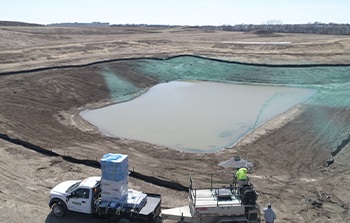If you’ve ever drove past new housing communities and noticed bright green foam covering the ground, it’s due to a process called hydroseeding.
Hydroseeding is a common erosion-control method done in Hubbell Land Development and subsequent construction to aide in stabilizing areas disturbed by new construction activity. It’s a blend of wood fiber mulch, fertilizers, tackifiers, grass seed and water that are mixed into a slurry. This slurry acts as a cover providing protection to retain the soil moisture which gives the seed planted below an opportunity to grow and thrive.
The bright teal coloration comes from the natural dyes in the wood fiber mulch that comes in prepackaged with the mix. It comes in this unique color so construction operators can be sure they’ve sprayed the entire coverage area evenly. The bright neon color typically fades after a day or so due to sun exposure and moisture evaporation.
The hydroseed is usually mixed in various sized mobile tanks that are taken to the jobsite and sprayed via a hose or cannon. Hydroseeding is often used either in place of, or in conjunction with, the other common method of site stabilization referred to as conventional seeding, which involves broadcast seeding such as applying straw coverage over top of the seed via a bale buster and a crimper.
Our land development erosion control vendors use hydroseed on almost every Hubbell development, like the one shown above at Holland Pointe in Norwalk. It is useful in smaller and hard-to-access areas. In the case of our new development at Holland Pointe, most of the site was conventionally seeded with straw, but hydroseed was used on the slopes and waterline of our sediment basins. We also routinely use hydroseed at our downtown sites such as Gray’s Station and the Bridge District urban communities where the bulkiness of the farm equipment used in conventional seeding can be difficult to maneuver around tighter city streetscapes. In either application, the most important factor is seed bed preparation. Just like any garden, the more well prepared and cultivated the seed bed is, the better chance for lush, green vegetation.
Seeding or establishing stabilizing vegetation is an important part of Hubbell Land Development’s environmental care and compliance regarding the prevention of as much construction-related soil erosion as possible. Established vegetation roots keep soil from running off during heavy rainfalls and high winds that we commonly experience in Iowa. Hydroseeding and conventionally seeding are just two erosion control best management practices we follow, both of which are laid out as guidance by the Environmental Protection Agency (EPA) through the Clean Water Act and enforced by the Iowa DNR which deals specifically with construction site related erosion control practices that apply across the real estate industry.
During the year, there are two generally accepted “seed windows” for both hydroseeding and conventional seeding: spring and fall. The spring window, March 1-May 31st, and fall window, August 10th- September 30th, is where most of the seeding activity occurs. Most seed vendors guarantee their product to grow during these moderate temperatures when there’s a higher chance for moisture and they generally cover the cost if seed does not take. Seeding can take place as needed outside of those times, but ideally, application occurs during or near those windows.
Learn more about Hubbell Land Development and the lots we have available for homebuilding purchases at newhomesiterealty.com.


Comments
ADD A COMMENT